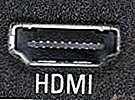 When a person buys his first laptop, usually the first thing he sees is a lot of holes of various shapes over almost the entire area of the device. The store can show where the connector for the power adapter is located, but, unfortunately, most often this is the end of the tour on the visible side of the laptop. However, not knowing the purpose of all the connectors, the user is unlikely to be able to achieve maximum performance from the device, especially if the device is equipped with modern Thunderbolt 3 outputs, etc.
When a person buys his first laptop, usually the first thing he sees is a lot of holes of various shapes over almost the entire area of the device. The store can show where the connector for the power adapter is located, but, unfortunately, most often this is the end of the tour on the visible side of the laptop. However, not knowing the purpose of all the connectors, the user is unlikely to be able to achieve maximum performance from the device, especially if the device is equipped with modern Thunderbolt 3 outputs, etc.
Multimedia connectors
Consider the most popular and most necessary outputs in a laptop for everyday tasks of the vast majority of users:
- VGA is the oldest, but sometimes still relevant connector for outputting images to an external display.
 HDMI - the connection interface replaces VGA; it is used to connect external monitors, home theaters, projectors, etc.
HDMI - the connection interface replaces VGA; it is used to connect external monitors, home theaters, projectors, etc.- The connectors for connecting audio equipment are quite recognizable, they have a linear shape, like on many still modern smartphones. The most common of them is the 3.5 mm jack jack, thanks to which it is possible to connect wired headphones.
- Thunderbot 3 is still a fairly rare type, first introduced in Apple products. This output has a throughput of 8 times higher than that of USB 3.0 and 4 times that of HDMI 1.4. This technology allows you to transfer high-resolution video without delay, connect external video cards, which sometimes is combined with the quick charge function.
Technical connectors
Now, smoothly move on to the most commonly used group of laptop interfaces:
- USB is an abbreviation in Russian that sounds entirely like a universal serial bus. The most common standard in the world for connecting external devices, be it a flash card, printer, smartphone, etc. Today, laptops are equipped with USB 2.0 ports. or 3.0. The 3rd generation connectors have a much higher throughput compared to the 2nd generation interface - 4.8 Gbps versus 480 Mbps.

- Ethernet - an interface for connecting a laptop to the Internet via a network cable using an RJ45 connector. Today, a laptop can have several standards of this technology that differ in data transfer speed: 1 thousand BASE-T, 100BASE-TX, 10BASE-T - allowing data to be transmitted at a speed of 10/100 Mbps or 1 Gbit per second.

Other ports
Sometimes in laptops there can be very unusual ports for modern models, which sometimes leads the user into a state of slight amazement. One of these ports can be safely called PS 2 and S-VHS, designed for interfaces of very old models of computer mice and keyboards.

Also, sometimes you can find the RJ-11 port, outwardly similar to the RJ-45, but designed to connect a telephone cable.


 HDMI - the connection interface replaces VGA; it is used to connect external monitors, home theaters, projectors, etc.
HDMI - the connection interface replaces VGA; it is used to connect external monitors, home theaters, projectors, etc.
Leave Your Comment